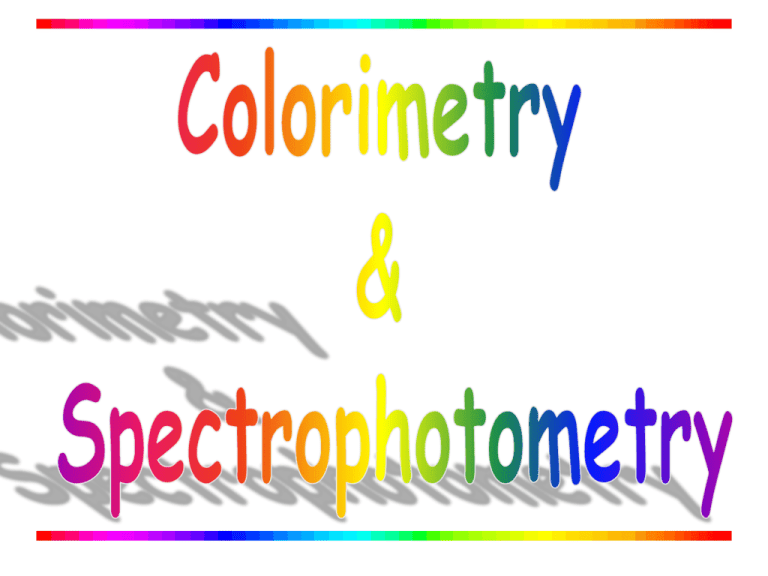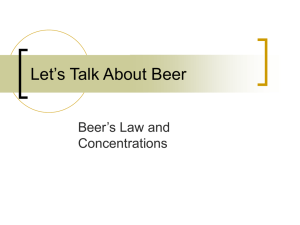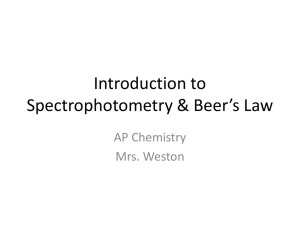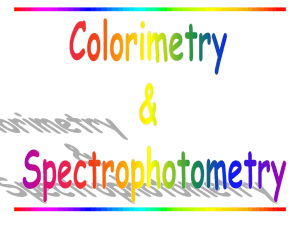Colorimetry.ppt
advertisement

Useful Terminology Colorimetry is the use of the human eye to determine the concentration of colored species. Spectrophotometry is the use of instruments to make the same measurements. It extends the range of possible measurements beyond those that can be determined by the eye alone. Note: This experiment will demonstrate both techniques on the same set of dyes. Colorimetry Visual Observations – Because colorimetry is based on inspection of materials with the human eye, it is necessary to review aspects of visible light. Visible light is the narrow range of electromagnetic waves with the wavelength of 400-700 nm. ROY G. BIV= the mnemonic used to remember the colors of the visible spectrum. Visible light is only a very small portion of the electromagnetic spectrum. Note: Frequency (υ) and Energy (E) are directly proportional whereas Frequency (υ) and Wavelength (λ) are inversely proportional. Electromagnetic Spectrum Type of Radiation Frequency Range (Hz) Wavelength Range Type of Transition gamma-rays 1020-1024 <1 pm nuclear X-rays 1017-1020 1 nm-1 pm inner electron ultraviolet 1015-1017 400 nm-1 nm outer electron visible 4-7.5x1014 750 nm-400 nm outer electron near-infrared 1x1014-4x1014 2.5 µm-750 nm outer electron molecular vibrations infrared 1013-1014 25 µm-2.5 µm molecular vibrations microwaves 3x1011-1013 1 mm-25 µm molecular rotations, electron spin flips* radio waves <3x1011 >1 mm nuclear spin flips* Electromagnetic radiation is characterized by its wavelength, , Frequency, and energy, E: E = h= hc / c= Where h = Planck’s constant & c = speed of light in a vacuum. (a) longer wavelength, lower energy; (b) shorter wavelength, higher energy. Color Wheel (ROYGBIV) Complementary colors lie across the diameter on the color wheel and combine to form “white light”, so the color of a compound seen by the eye is the complement of the color of light absorbed by a colored compound; thus it completes the color. Observed Color of Compound Color of Light Absorbed Approximate Wavelength of Light Absorbed Green 700 nm Blue-green 600 nm Violet 550 nm Red-violet 530 nm Red 500 nm Orange 450 nm Yellow 400 nm Observed Color of Compound Color of Light Absorbed Approximate Wavelength of Light Absorbed Green Red 700 nm Blue-green Orange-red 600 nm Violet Yellow 550 nm Red-violet Yellow-green 530 nm Red Green 500 nm Orange Blue 450 nm Yellow Violet 400 nm Visual Colorimetry Intensity: For light shining through a colored solution,the observed intensity of the color is found to be dependent on both the thickness of the absorbing layer (pathlength) and the concentration of the colored species. ←Side view ←Top view (a.k.a. Bird’s eye view) For One Color: A series of solutions of a single color demonstrates the effect of either concentration or pathlength, depending on how it is viewed. Visual Colorimetry ←Ratio used ←Purple produced For more than one color: the ratio of an unknown mixture can also be determined by matching the shade of the color to those produced from known ratios. In this example, the ratio of a mixture of red and blue can be determined visibly by comparing the mixture to purples produced from known ratios of red and blue. Dilution Factor (constant pathlength) Recall: C1V1= C2V2 Then for the dilution, Cdiluted x Vdiluted= Cstd x Vstd Cdiluted = Cstd x (Vstd / Vdiluted) Since Vdiluted = Vtotal Cdiluted = Cstd x (Vstd / Vtotal) Substituting the volumes: Cdiluted = Cstd x (3 drops / 8 drops) 3 drops of dye std + 5 drops water 8 drops total volume If the original concentration is 5.88 ppm, then: C diluted = 5.88 ppm x (3 / 8) C diluted = 2.21 ppm Intensity: When the product of the concentration and the pathlength of any two solutions of a colored compound are the same, the same intensity or darkness of color is observed. Duboscq visual colorimeter Adjustable Path Lengths Spectrophotometry Spectrophotometer - an instrument that measures the amount of light absorbed, or the intensity of color at a given wavelength. The intensity of color can be given a numerical value by comparing the amount of light prior to passing it through the sample and after passing through the sample. These quantitative measurements of light absorbed are the Transmittance and the Absorbance. Absorbance Beer-Lambert Law (a.k.a. Beer's law) - the linear relationship between absorbance and concentration of an absorbing species. A = abc A is the absorbance “a” is molar absorptivity in L/[(mole)(cm)] Also called “extinction coefficient” or “”; it is dependent on the material being studied. “b” is the path length in cm The diameter of the cuvette or sample holder which is the distance the light travels through the absorbing sample. “b” is a constant when the same size cuvette is used for all samples. “c” is the concentration of the sample in (mol/L) Main use of Beer’s Law is to determine the concentration of various solutions. Transmittance is Related to Absorbance Transmittance is given by the equation: T = I/Io where I is the intensity of the light after it has gone through the sample & Io is the initial light intensity. Absorbance is related to the %T: A = -logT = -log(I/ Io) Equation Summary T= (I/Io) = 10-A %T = (I/Io) x 100 A = -logT = log(1/T) Sample Calculation If %T = 95%, then A = log(100/95) = log(1/.95) = -log(.95) A = 0.02227 Note the scale for Absorbance: 9/10th of the scale is from 0-1 and 1/10th is from 1-2. For this reason, the spectrometers have been calibrated in % Transmittance and all readings will be taken in %Transmittance. Spectronic 20 (a.k.a. Spec-20) Spec-20 - A single-beam visible light spectrophotometer. Tungsten filament lamp emits visible wavelengths of light. Blank is inserted to adjust 100%Transmittance at each wavelength. Simple Spectrophotometer Schematic The lamp emits all colors of light (i.e., white light). The monochromator selects one wavelength and that wavelength is sent through the sample. The detector detects the wavelength of light that has passed through the sample. The amplifier increases the signal so that it is easier to read against the background noise. Spectronic 20 Instructions (Directions below will be available next to each instrument) Sample Chamber Digital Display Mode Knob (set to Trans) 1. With sample chamber empty, set desired wavelength then adjust to 0%T with right knob on front panel. 2. Insert blank solution, close lid and adjust 100%T with right knob on front panel. 3. Insert dye solutions, read and record %T values. 4. Change wavelength*, repeat steps 2-4. Filter Lever Wavelength Knob 0-100%T Knob *NOTE: The filter must be changed periodically to coordinate with the wavelength range studied: blue (400-449), green (450-549) and orange (550-749). Post Lab: 4 Plots of Absorption Data Plots similar to the 3 below will need to be generated using a computer program such as Excel. You will also need to make a plot of your unknown blue or red which will look similar to #1 or #2. #1 1.4 1.6 450 500 550 600 Wavelength (nm) 650 1.2 1 400 1 0.4 #3 500 550 600 Wavelength (nm) 650 700 Plot of Abs. vs nm for Pur ple Red/Blue Dye mix 500 550 600 Wavelength (nm) 650 0.5 700 0.4 0.3 0.1 0 400 450 0.6 0.2 -0.2 450 450 0.7 400 0.8 0.6 0.2 0 0.9 0.8 -0.2 700 1.4 0.4 0 Overlay Plot of Blue and Red dye Abs. vs nm curves 1.6 0.6 0.8 0.2 0 400 Absorbance Absorbance 0.4 Absorbance Absorbance 0.6 1 0.8 1.2 1 Plot of Abs. vs nm for Red Dye 1.4 1.2 0.2 #2 Plot of Abs. vs nm for Blue Dye 500 550 600 Wavelength (nm) 650 700 Checkout Visual Portion 1 - 12 well plate 3 - 12 well strips* 5 - Beral pipets** Spec-20s 5 - cuvettes in a test tube rack *2 of which need to be at least 9 wells long. **Don’t have to be returned. There aren’t enough Spec-20s for all groups. So 1/2 will start with the Spec-20s and 1/2 will start with the visual portion. Dyes - Located in Lab: Record Concentrations Blue std. = _____ ppm Red std. = _____ ppm Waste We are using FDA food dyes and distilled water. For April 9-12 Turn In: Colorimetry & Spectrophotometry pp 51-58 + 4 Graphs Read Over: Antacid Analysis (pp 33-34) in Green Book & Dimensional Analysis #4-5 (pp 28-34 in the first book).







